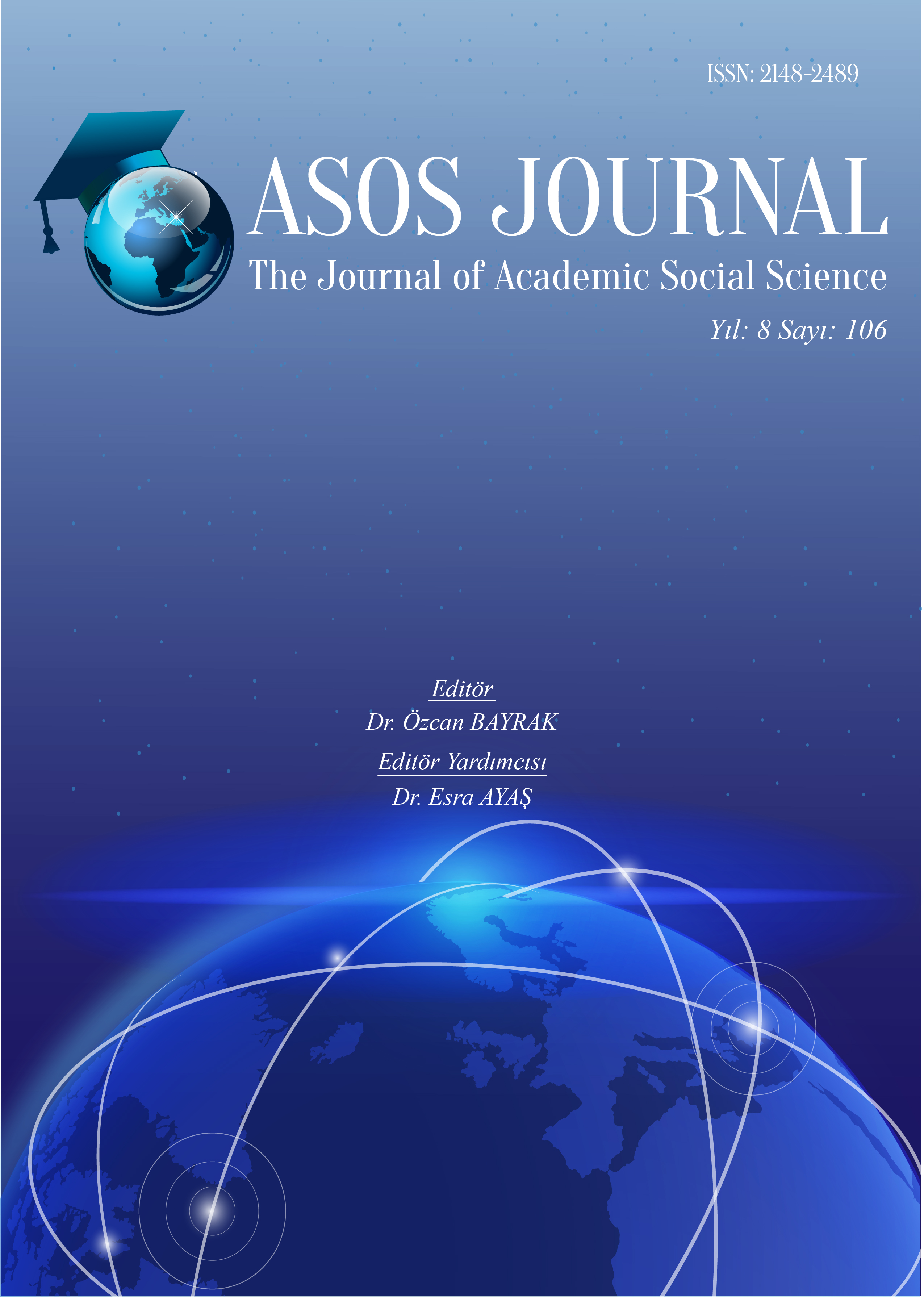Author :
Abstract
Görsel sanatlar alanında Rönesans ile başlayan ve yirminci yüzyıla kadar devam eden teknolojik buluşlar, yenilikçi sanat hareketleri modern sanatı biçimlendiren temel etkenler olmuştur. 19.yüzyıl sanatında, görüntünün parçalandığı, görme biçimlerinin değişmeye başladığı, sanatta ‘mimesise’ dayalı düşünce biçiminin yıkıldığı, natüralizmin (doğalcılık) reddi üzerine kurulu yeni arayışları ve öncü tavırları görebilmekteyiz. 20. yüzyılda ortaya çıkan sanat akımları, yeni bir görsel dil oluşturma çabası içinde fotoğraftan ve teknolojiden etkin bir biçimde yararlanmıştır. Bu çalışmanın amacı ve kapsamı; akılcı ve deneysel tavrın sanata yansıması, modern sanatın, deneysel ve öncü sanat hareketlerinin günümüz sanatını belirlemedeki etkin gücünün araştırılmasıdır. Sanatta analog sistemlerden bilgisayar teknolojilerine, dijital teknolojiden yeni medya sanatına kadar uzanan süreçte sanatsal yaklaşımların ve düşünce biçimlerinin temel çıkış noktalarının incelenmesidir. Sanatta öncü, yenilikçi ve deneysel yaklaşımların izlerini geçmişten günümüze dönem, sanatçı ve eserler bağlamında incelemek; sanatın tarihsel süreç içinde nasıl geliştiği ve geleceğin sanatsal yaklaşımları hakkında ip uçlarının saptanması açısından da önemlidir.
Keywords
Abstract
Technological inventions and innovative art movements, which started with the Renaissance in the field of visual arts and continued until the twentieth century, were the main factors shaping modern art. In the 19th century of art, we can see new quests and pioneering attitudes based on the rejection of naturalism (naturalism), in which the image disintegrated, the ways of seeing began to change, the way of thinking based on ‘mimesis’ in art was destroyed. The art movements that emerged in the 20th century have made effective use of photography and technology in an effort to create a new visual language. The aim and scope of this study is to investigate the reflection of rational and experimental attitude to art and determine the effective power of modern art, experimental and pioneering art movement on today’s art. Moreover, the main points of artistic approaches and ways of thinking in art is investigated in the period ranging from analog systems to computer technologies, from digital technology to new media art. To research the traces of pioneering, innovative and experimental approaches in art in the context of the past, present, artists and works is also important in terms of determining how art has developed in the historical process and the clues about artistic approaches of the future.
Keywords
- Benjamin, W. (1993), Pasajlar - Tekniğin Olanaklarıyla Yeniden Üretilebildiği Çağda Sanat Yapıtı, (Çev., Ahmet Cemal), Yapı Kredi Yayınları, İstanbul.
- Bürger, P. (2004), Avangard Kuramı, (3. Baskı), İletişim Yay., İstanbul.
- Derman, İ. (1991), Fotoğraf ve Gerçeklik, Ağaç Yayıncılık, İstanbul.
- Fıneberg, J. (2014), 1940’dan Günümüze Sanat, (Çev., S. Atay-Eskier, G. E. Yılmaz), Karakalem Kitapevi Yayınları, İzmir.
- Gökberk, M. (1980), Fesefe Tarihi, 4. Basım, Remzi Kitabevi, İstanbul.
- Habermas, J. (1994), Modernlik: Tamamlanmamış bir Proje’, Postmodernizm, Necmi Ziya (haz.), Kıyı Yayınları, istanbul.
- Kahraman, H.B. (1995), Sanatsal Gerçeklikler, Olgular ve Öteleri, YKY, İstanbul.
- Levi-Strauss, C. (1994), Yaban Düşünce, (Çev., T. Yücel), YKY, İstanbul.
- Raunig, G. (2016), Bilgi Fabrikaları – Yaratıcılık Endüstrileri, (Çev., Aslı Çetinkaya) 8/12/2016, skopbülten, https://www.e-skop.com/skopbulten/bilgi-fabrikalari%E2%80%93-yaraticilik-endustrileri/3191, Erişim Tarihi: 03 Mayıs 2020].
- Líder do Movimento Concretista nas Artes Plásticas de São Paulo na Década de 50 (Waldemar Cordeiro: Vanguard Painter, Promoter, Art Critic, Theoretician and Leader of the Concrete Art Movement in the 1950s) (São Paulo: Escola de Comunicações e Artes da Universidade de São Paulo, 1982) pp. 83--84.
- Yacavone, K. (2015), Benjamin, Barthes ve Fotoğrafın Tekilliği, (Çev., Simber Atay, Melih Tumen), Hayalperest Yayınevi, İstanbul.
- https://www.tarihlisanat.com/wp-content/uploads/2018/01/detay-5-1.jpg , Erişim Tarihi: 11.04.2020
- Görsel 2 : Resim 1’den Detay https://www.tarihlisanat.com/wpcontent/uploads/2018/01/detay-5-1.jpg, Erişim Tarihi:
- Görsel 3 : Giotto di Bondone, No. 36 Scenes From The Life of Christ, 20. Lamentation (The Mourning of Christ), 1304-06 http://www.leblebitozu.com/ronesans-donemiressamlari-ve-tablolari Erişim Tarihi: 08.05.2020
- Görsel 6 : Max Ernst, Yaklaşan Ergenlik, Kartona Yapıştırılmış Kağıt Üzerine Rötuşlu Fotoğraflar, Guaş ve Yağlıboya Kolaj, 24.5x16.5cm, Max Ernst, 1921 https://twitter.com/celinesymbioss/status/613782808289525760, Erişim Tarihi: https://www.istanbulsanatevi.com/sanatcilar/soyadi-p/picasso-pablo/pablo-picassogitar- 9520/ Erişim Tarihi: 08.05.2020 https://kavrakoglu.com/cagdas-sanata-varis-41-kubizm-2/, Erişim Tarihi: 08.05.2020
- Görsel 9: Marcel Duchamp, Bisiklet Tekerleği, Metal tekerlek, boyalı tahta tabure, 129.5 x 63.5 x 41.9 cm. 1951. https://blog.peramuzesi.org.tr/sergiler/marcel-duchampinbisiklet-tekerlegi/, Erişim Tarihi: 08.05.2020
- Görsel 10 : Marcel Duchamp, Büyük Cam, İki cam panelde yağ, vernik, kurşun folyo, kurşun tel ve toz, 277,5 cm × 175,9 cm. 1915-1923. https://en.wikipedia.org/wiki/The_Bride_Stripped_Bare_by_Her_Bachelors,_Even, Erişim Tarihi: 08.05.2020
- Görsel 11 : Richard Hamilton “Bugünün evlerini bu denli cazip kılan nedir?” Kolaj, (41,9 x 29,8 cm) 1956. https://gaiadergi.com/richard-hamilton-bugunun-evlerini-denli-farklidenli-cazip-kilan-nedir/, Erişim Tarihi: 08.05.2020
- Görsel 12 : Edward Weston, “ Biber No 30 ”, Siyah- Beyaz Fotoğraf, 1930. https://edward- weston.com/edward-weston/, Erişim Tarihi: 08.05.2020
- Görsel 13 : Man Ray, Rayograph (The Kiss), Fotoğraf, 1922. https://www.sartle.com/artwork/the-kiss-man-ray-1922, Erişim Tarihi: 08.05.2020
- Görsel 14 : Waldemar Cordeiro, Gente Ampli/2, Computer output on paper, 1972, MOMA. https://www.moma.org/collection/works/183547, Erişim Tarihi: 08.05.2020
- Görsel 15 : Resim 14’den Ayrıntı. https://www.moma.org/collection/works/183547, Erişim Tarihi: 08.05.2020
- Görsel 16 : Waldemar Cordeiro “BB (Brigitte Bardot) olmayan kadın, Bilgisayar grafiği, 61 × 44.5 cm, 1971. https://artsandculture.google.com/asset/the-woman-who-is-not-bb-waldemarcordeiro/1AGGG7oU7B_rNg, Erişim Tarihi: 08.05.2020
- Görsel 17 : Resim 16‘dan Ayrıntı. https://artsandculture.google.com/asset/the-woman-who- is-not-bb-waldemar- cordeiro/1AGGG7oU7B_rNg, Erişim Tarihi: 08.05.2020
- Görsel 18 : Gustav Metzger, “ Tarihi Fotoğraflar; Sürünerek Girmek-İlhak, Viyana, Mart 1938 ” fotoğraf, yerleştirme, 1996/201 http://izlekler.com/wpcontent/uploads/2017/07/Gustave-Metzger.jpg, Erişim Tarihi: 08.05.2020
- Görsel 19 : Gustav Metzger, Likit Kristal Çevre, Beş modifiye slayt projektörü, sıvı kristal, 35mm slayt, Polaroid filtre ve bilgisayarlı kontrol, süresi: 22 dakika, , 1965,yeniden yapılanma 2005. https://www.tate.org.uk/art/artists/gustav-metzger-7196, Erişim





